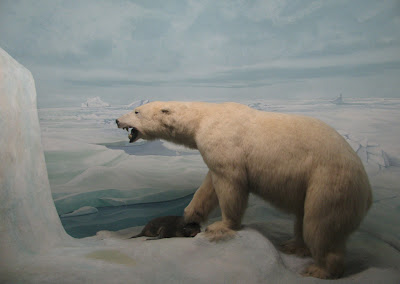Located at the edge of Center City Philadelphia, the Mütter Museum is one of the city’s most peculiar institutions. Part of the College of Physicians of Philadelphia, the Museum is home to a collection of more than 25,000 objects and artifacts relating to the study and practice of medicine. Packed tightly in the vitrines that line the walls are an odd, and often unsettling, collection of specimens.
The Mütter is a science museum with the disposition of a sideshow. Here, the visitor comes face to face with faces and pieces of faces, skulls and brains both whole and cross-sectioned, and diseased tissue and swollen organs of all shapes and sizes (including an ovarian cyst the size of a watermelon). There are displays devoted to the “Natural History of Crime” and Teratology (the study of malformed fetuses). There is the skeleton of an “American Giant” (at 9’2” the tallest skeleton on display in North America), the plaster death cast of Siamese twins Chang and Eng, and a selection of books bound in human skin. It’s enough to make even the sturdiest of visitors a bit squeamish.
Most of the Mütter’s specimens are from the nineteenth century and early-twentieth century and reflect the strange impulses and interests that mark the evolution of science and medicine. The museum’s permanent collection is housed on two floors and situated in the center of the building. The open floor plan allows the visitor to see what is above and below. The layout recalling surgical auditoriums of old, the crowded display cases the back room of a medical laboratory or library. The collection is presented using an open storage model. The cabinets are filled – nearly overflowing – with artifacts. Objects are arranged according to subject in heavy glass cases. Informational text identifies the objects and situates them in terms of medical history. There is little separating the visitor from the specimens, a distinct lack of artifice.
Two additional exhibit halls are located adjacent to the permanent collection and host a revolving series of exhibits that draw on the museum’s extensive holdings. Currently on display is a Civil War centered exhibit that uses Lincoln’s assassination and the aftermath, as the starting point for an examination of the medical practices of the period. The assassination of Grover Cleveland is also discussed. In the next room – “Rarely Seen: Hidden Collections from the Mütter Museum” – an exhibit highlighting some of the museum’s many medical objects. Here, visitors can view “strange medical devices” including an iron lung and a device that uses x-rays to fit shoes (dosing everyone involved with high levels of radiation).
A large cabinet with many drawers sits beneath the staircase in the lower gallery. In it, the Dr. Chevalier Jackson collection which contains some 2,000 foreign objects removed from the throats of his patients. There are pinbacks (one touting “Perfect Attendance” and another promoting traffic safety – “B-A 2-Way Looker”) and metal jacks, a reed from a toy saxophone and half a radiator key, safety pins and carpet tacks, and on and on. It is an astounding (and meticulously documented) collection, which serves as both a testament to Dr. Jackson’s dexterity and as a catalog of early twentieth century (mass-produced) material culture.
There is humanity in the Mütter’s specimens that is absent at other science museums. The exhibits tell the human story of science and medicine. Further, it is a place that stokes visitor’s sense of wonder and curiosity. In this way it recalls the Wagner Free Institute of Science. Further, it serves as an extension of Charles Wilson Peale’s impulse toward “rational amusement” – the combination of education and entertainment characteristic of his American Museum. It also reflects the collection and display practices of the sixteenth century Wunderkammern. Stephen Greenblatt describes the cabinets of wonder as places where the “expression of wonder stands for all that cannot be understood, that can scarcely be believed. It calls attention to the problem of credibility and at the same time insists upon the undeniability, the exigency of experience.” Greenbaltt’s description provides a sense of the Mütter experience. It is a place that combines the natural and the man-made, the fantastic and strange, and instills awe, wonder, and often doubt in the visitor.
For more information, check out the College of Physicians and the Mütter Museum on Facebook.com.



+Exit.JPG)


